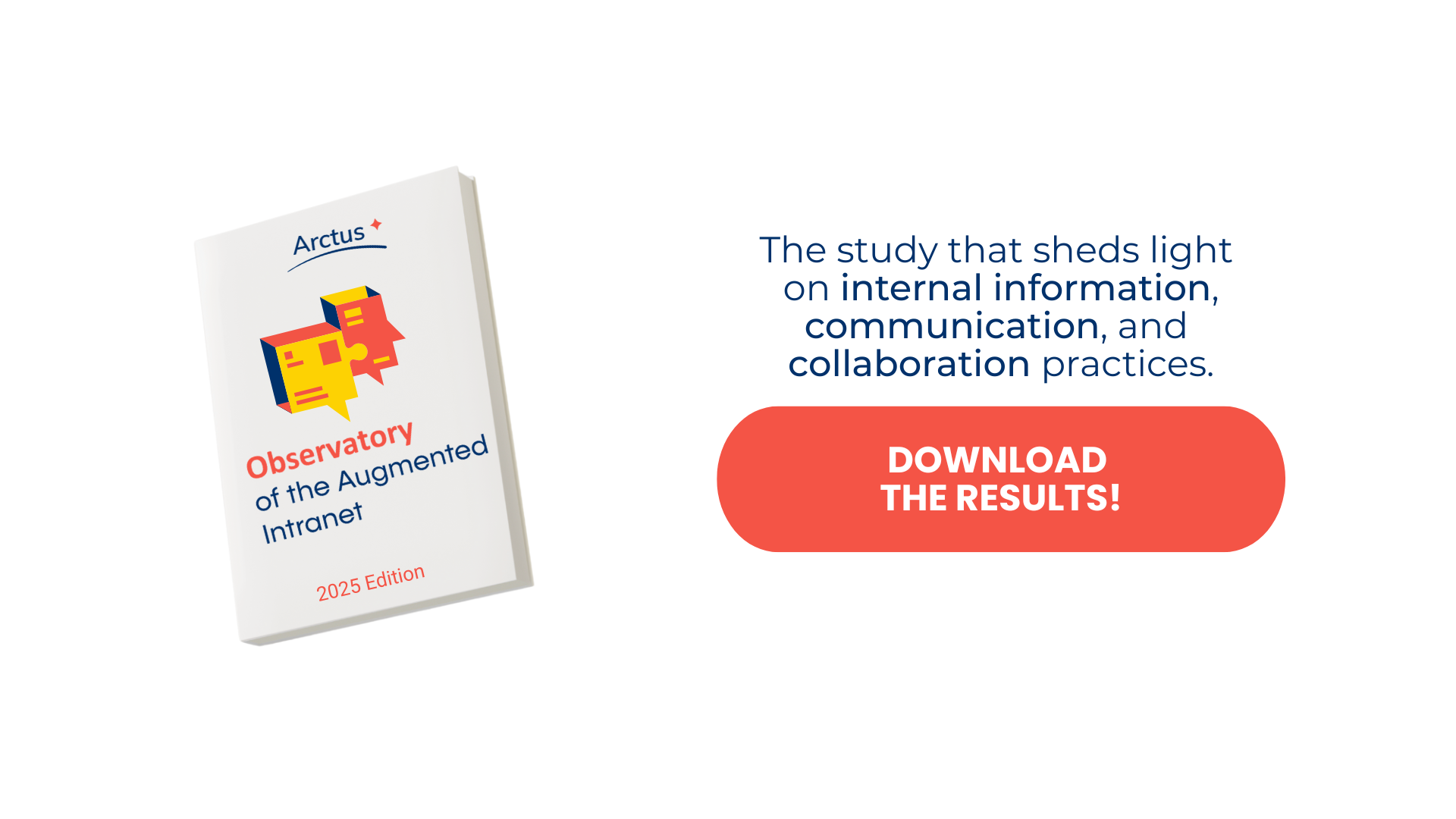TOWARDS A RESPONSIBLE AND SUSTAINABLE INTRANET AND DIGITAL WORKPLACE

24 June 2025

Indispensables à la collaboration et à la communication interne, les outils numériques tels que l’intranet et la digital workplace jouent un rôle stratégique. Selon l’Observatoire 2025 de l’intranet, 94 % des professionnels considèrent l’intranet comme indispensable ou nécessaire. Ces plateformes s’imposent ainsi comme un levier clé pour initier une démarche de sobriété numérique à l’échelle de l’entreprise.
Mais comment intégrer concrètement ces enjeux dans la conception, la gestion et l’évolution des outils numériques internes ? De la prise de conscience environnementale à la mise en œuvre d’une gouvernance durable, en passant par des pratiques concrètes dans l’intranet ou la digital workplace et un usage raisonné de l’IA, explorons les leviers pour allier performance, efficacité et responsabilité.
Understanding Responsible Digital: an underestimated challenge for intranets and the digital workplace
Le numérique responsable désigne l’ensemble des pratiques visant à réduire volontairement l’empreinte environnementale, économique et sociale des technologies de l’information et de la communication. Cette empreinte ne se limite pas à l’utilisation quotidienne de ces outils, mais couvre l’ensemble de leur cycle de vie : de la conception à la fin de vie des équipements.
Si le sujet du numérique responsable gagne en visibilité, il reste encore peu intégré dans les réflexions liées aux intranets et à la digital workplace, pourtant au cœur du quotidien numérique des collaborateurs.
Aujourd’hui, les émissions de gaz à effet de serre du numérique sont comparables à celles de l’aviation civile. Et ce poids ne cesse de croître, notamment en raison de la multiplication des équipements.

On compte près de 34 milliards de terminaux pour 4,1 milliards d’utilisateurs, soit en moyenne 8 équipements numériques par personne. Ce sont précisément ces équipements qui posent le plus grand défi : entre 59 % et 84 % de l’empreinte environnementale du numérique leur est imputable, bien plus que des centres de données ou des réseaux.
Dans ce contexte, les intranets, digital workplace et autres plateformes collaboratives doivent évoluer. Leur conception, leur gouvernance et leur usage doivent désormais intégrer les principes du numérique responsable, au risque de contredire les engagements RSE des entreprises.
Integrating sustainable practices into the intranet and the digital workplace: practical steps towards effective digital sobriety
L’intranet et la digital workplace constituent des points d’entrée stratégiques pour initier ou renforcer une démarche de sobriété numérique au sein de l’entreprise. En tant que hubs d’information, de collaboration et de services, ils concentrent une part importante des usages numériques quotidiens — Ils constituent donc un fort potentiel d’optimisation.
Voici quelques bonnes pratiques concrètes à intégrer dès la conception ou l’évolution de ces environnements :
- Centraliser et rationaliser les contenus pour limiter les doublons, les silos documentaires et les versions multiples, souvent synonymes de stockage superflu et de désorganisation.
- Favoriser le partage de liens plutôt que l’envoi de pièces jointes par email, afin de réduire l’empreinte des échanges internes.
- Déployer des outils collaboratifs adaptés aux usages (chat, canaux projet, commentaires intégrés) pour alléger les boîtes mail et fluidifier les interactions.
- Personnaliser l’accès à l’information en fonction des profils pour limiter les recherches énergivores et réduire le bruit informationnel.
- Mutualiser les développements techniques via des marketplaces internes, évitant les redondances et renforçant l’interopérabilité entre outils.

Ces pratiques, souvent perçues comme accessoires, sont en réalité structurantes pour une digital workplace plus responsable, plus fluide — et donc plus performante.
Towards eco-responsible artificial intelligence in the intranet and digital workplace
L’Intelligence Artificielle s’invite progressivement dans les intranets et les environnements de digital workplace (consultez notre article dédié sur ce sujet). Recherche intelligente, assistants virtuels, recommandations de contenu : ces fonctionnalités promettent des gains d’efficacité, mais leur déploiement n’est pas sans conséquences sur le plan environnemental.
Intégrer l’IA dans une démarche de sobriété numérique suppose un arbitrage entre valeur ajoutée et empreinte carbone.
Plusieurs leviers peuvent guider cette approche responsable :
- Évaluer les besoins réels en amont : parfois, une logique métier bien pensée peut répondre au besoin sans recourir à des modèles complexes et énergivores.
- Optimiser les algorithmes : privilégier des modèles plus légers, utiliser des techniques de compression ou d’entraînement distribué permet de limiter la consommation de ressources.
- Choisir des infrastructures durables : héberger les solutions dans des data centers certifiés et alimentés par des énergies renouvelables contribue à réduire l’impact global.
- S’appuyer sur des solutions open source et maîtrisées, offrant davantage de transparence et une meilleure adaptation aux usages internes.
Dans une digital workplace écoresponsable, l’IA doit être envisagée comme un moyen au service de l’efficacité des usages, et non comme une fin en soi.
Implementing sustainable governance for an eco-responsible intranet

Sans gouvernance adaptée, les initiatives de sobriété numérique portées par l’intranet ou la digital workplace risquent de rester ponctuelles et isolées. Pour inscrire ces initiatives dans la durée, il est essentiel de structurer une approche transverse, pilotée et alignée avec les priorités RSE de l’entreprise.
Plusieurs leviers permettent de bâtir cette gouvernance durable :
- Mettre en place un comité dédié au numérique responsable, réunissant les parties prenantes clés : IT, communication interne, RH, RSE. Ce comité peut piloter la feuille de route, définir des indicateurs de performance environnementale et suivre leur évolution dans le temps.
- Sensibiliser les collaborateurs, en animant des campagnes internes et des ateliers pour promouvoir les bons réflexes : maîtrise des usages, tri des contenus, sobriété des outils.
- Intégrer la durabilité dans les processus de sélection et de gestion des outils, en ajoutant des critères environnementaux dans les cahiers des charges, les appels d’offres et les cycles de vie applicatifs.
Cette gouvernance n’est pas un simple cadre : c’est le socle qui permet à l’intranet, à la digital workplace de devenir des leviers concrets de transformation responsable.
What if digital sobriety became a driver of transformation?
Adopter une démarche écoresponsable dans la gestion de l’intranet et de la digital workplace, ce n’est pas seulement réduire l’empreinte carbone de l’organisation. C’est aussi renforcer la performance, la cohérence des usages et l’engagement des collaborateurs au quotidien.
Des choix technologiques à la gouvernance, en passant par les pratiques quotidiennes, chaque action compte pour bâtir un environnement numérique plus sobre, plus utile, et pleinement aligné avec les enjeux RSE de l’entreprise.
Contrairement aux idées reçues, la sobriété numérique ne freine pas la transformation digitale. Elle en redéfinit les contours, en la rendant plus durable, plus résiliente — et surtout, plus humaine.
Chez Arctus, nous accompagnons les organisations dans cette évolution, en intégrant ces enjeux dès les premières réflexions autour de leur intranet ou de leur digital workplace.
Et si c’était le bon moment pour enclencher cette dynamique dans votre entreprise ?
Sources :
- Le numérique responsable : quels avantages pour les entreprises ?
- Saisir les opportunités de l’IA pour un numérique responsable : nouveau rapport disponible !
- Numérique responsable et IA : une alliance possible ?
- Intelligence artificielle (IA) et numérique responsable
- Numérique responsable : Guide des bonnes pratiques à adopter
- Le numérique responsable, nouveau défi des entreprises


